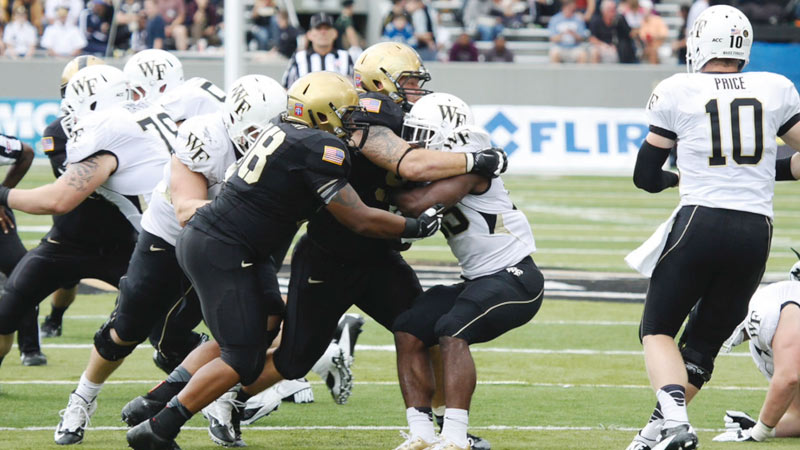Football defense strategies are as diverse as the game itself, with coaches and teams constantly seeking innovative ways to gain an edge on the field. One such strategy that has gained prominence in recent years is the Football Over Under 4-3 Defense.
This defensive scheme is designed to disrupt the opponent’s offense, create pressure on the quarterback, and control the line of scrimmage.
Whether you’re a passionate football enthusiast or just looking to expand your knowledge of defensive tactics, this guide will take you through the intricacies of Football Over Under 4-3 Defense.
What Is Football Over Under 4-3 Defense?
The Over-Under 4-3 Defense is a tactical variation of the standard 4-3 defensive formation in football. In this scheme, the defensive alignment shifts based on the offensive formation, enhancing the defense’s adaptability and effectiveness.
In the Over 4-3 alignment, the defensive linemen and linebackers shift toward the strong side of the offensive formation, where the tight end or more offensive players are positioned. This creates a concentrated front, aiming to overpower the offense and seal running lanes.
On the contrary, the Under 4-3 alignment involves shifting the defensive front toward the weak side of the formation, away from the tight end or offensive strength.
This strategic adjustment aims to exploit potential mismatches and maintain better coverage while still maintaining solid run defense. The Over-Under 4-3 Defense demands a high level of coordination, communication, and quick decision-making from defenders.
Components of Football Over Under 4-3 Defense
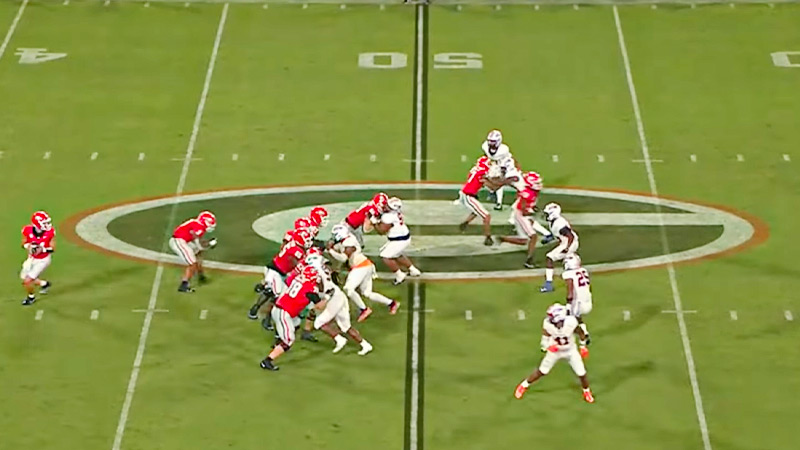
The Football Over-Under 4-3 Defense consists of several key components that contribute to its effectiveness in countering various offensive strategies:
Defensive Linemen Assignments
In both Over and Under alignments, the defensive linemen are responsible for specific gaps along the line of scrimmage. Their primary goal is to disrupt the offensive line, create penetration, and disrupt running plays or pressure the quarterback on passing plays.
Linebacker Roles
The three linebackers in the 4-3 Defense have diverse responsibilities. The middle linebacker (MLB) often serves as the leader of the defense, reading plays, and making adjustments. The strong-side linebacker (SLB) and weak-side linebacker (WLB) support both run defense and pass coverage, adjusting their positioning based on the Over-Under shift.
Defensive Line Techniques
Defensive linemen employ different techniques based on whether they’re in the Over or Under alignment. In the Over shift, they might engage in “pinching” techniques to collapse the line, while in the Under shift, they might focus on using “slanting” techniques to exploit gaps and create pressure.
Gap Responsibilities
The defensive linemen and linebackers work together to cover specific run gaps based on the alignment. Gap assignments ensure that there are no open lanes for running backs and that the defense can funnel plays toward areas with better coverage support.
Defensive Backs Support
The defensive backs, including cornerbacks and safeties, provide coverage support to defend against passing plays. Their positioning and coverage responsibilities may adjust slightly depending on whether the defense is in the Over or Under-alignment.
Alignment Flexibility
The key feature of the Over-Under 4-3 Defense is its adaptability. The defense can switch between the Over and Under alignments before the snap, allowing it to counter the offense’s strengths effectively. This requires strong communication among defenders to ensure everyone is on the same page.
Pre-snap Adjustments
The defensive captain or middle linebacker often reads the offensive formation and makes adjustments to the alignment and assignments of the defense. These adjustments could involve shifting from Over to Under or vice versa, based on the offensive setup.
Pass Rush and Coverage Balance
The defense aims to strike a balance between generating a pass rush and maintaining coverage in the secondary. The alignment adjustments help create mismatches and provide the defense with an advantage to pressure the quarterback or stifle running plays.
The Football Over-Under 4-3 Defense’s success relies on the cohesion and understanding among its players, who must be prepared to adjust their positioning and responsibilities on the fly to counter the ever-changing offensive landscape.
Over 4-3 Defense and Under 4-3 Defense
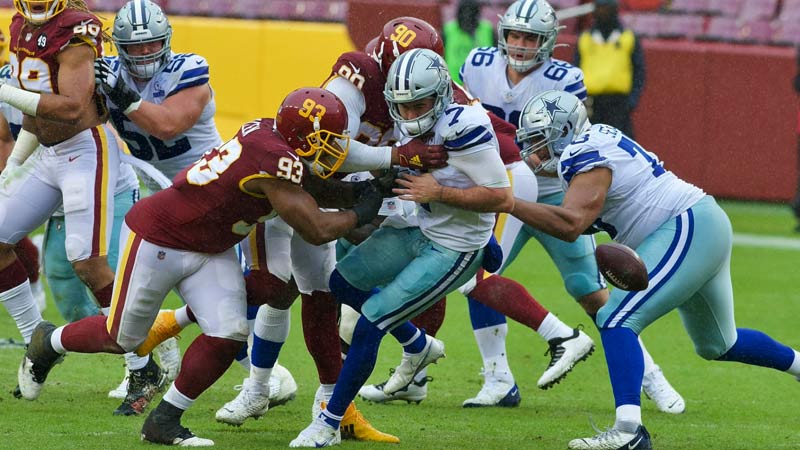
The Over 4-3 Defense and Under 4-3 Defense are specific variations of the 4-3 defensive formation in football, each strategically designed to counter different offensive schemes and exploit opponent weaknesses.
Over 4-3 Defense
In the Over 4-3 Defense, the defensive linemen and linebackers shift toward the strong side of the offensive formation.
This means they align themselves towards the side where the tight end or more offensive players are positioned. The objective is to overload that side, creating a concentrated front to dominate the line of scrimmage, control gaps, and effectively stop the run.
By shifting toward the offensive strength, the defense aims to overwhelm blockers and collapse running lanes. This alignment also provides solid coverage on that side, making it difficult for the offense to find open passing lanes.
Under 4-3 Defense
Conversely, the Under 4-3 Defense involves shifting the defensive front toward the weak side of the offensive formation, away from the tight end or offensive strength.
This alignment is aimed at exploiting potential mismatches and maintaining better coverage, especially against pass-heavy formations. By aligning away from the offensive strength, the defense aims to disrupt blocking assignments and create confusion among the offensive linemen.
This can lead to pressure on the quarterback and make it challenging for the offense to establish a balanced attack.
Both the Over and Under 4-3 Defenses require a high level of communication, coordination, and quick decision-making among defenders. The ability to shift alignments based on the offensive setup provides a strategic advantage, allowing the defense to adapt to various situations.
These defensive variations also emphasize the importance of gap assignments, where defensive linemen and linebackers work together to ensure that there are no open lanes for running backs and that the defense can control the line of scrimmage effectively.
When to Use Football Over Under 4-3 Defense?
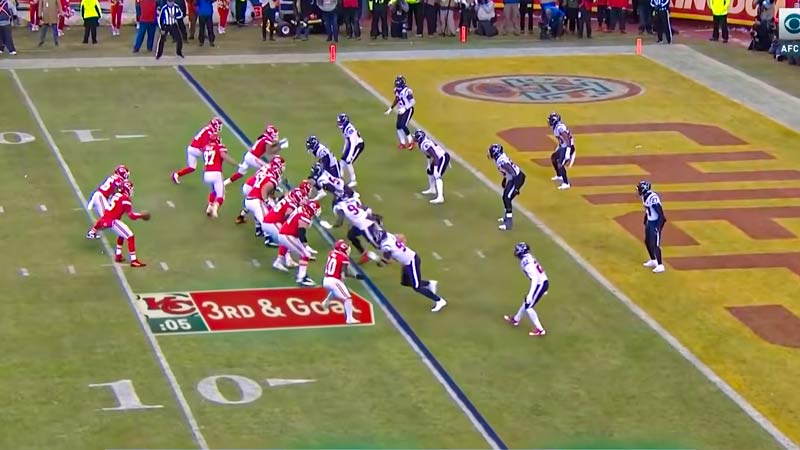
The decision of when to use the Football Over-Under 4-3 Defense depends on various factors, including the opponent’s offensive tendencies, field position, down and distance, and game situation. Here are some scenarios when the Over-Under 4-3 Defense could be strategically advantageous:
Run-Heavy Opponents
If you’re facing an opponent with a strong running game, the Over 4-3 Defense can help by concentrating defensive strength on the side of the offensive formation where the run is more likely to occur. This alignment aims to overwhelm blockers and clog running lanes.
Passing Situations
In situations where you expect the opponent to pass the ball, the Under 4-3 Defense might be more effective. Aligning away from the offensive strength can create confusion for the offensive linemen, making it challenging for them to protect the quarterback effectively.
Formation Tendencies
Study the opponent’s offensive formation tendencies. If they consistently line up with a strong side (e.g., with a tight end), the Over 4-3 Defense can help counter their strengths. If they spread the field evenly or have a weak side, the Under 4-3 Defense might be more appropriate.
Field Position
Consider the field position. If the opponent is backed up near their own goal line, the Over 4-3 Defense can be effective in preventing a running play from gaining momentum. The Under 4-3 Defense might be chosen to prevent big passing plays and maintain coverage in open-field situations.
Down and Distance
Analyze the down and distance. If it’s an obvious passing down, opting for the Under 4-3 Defense can provide better coverage options. On short-yardage situations, the Over 4-3 Defense can be used to stuff the run.
Game Situation
Depending on the score and time left in the game, your defensive strategy might change. If you’re ahead and trying to protect a lead, using the Under 4-3 Defense can help prevent big plays. If you’re behind and need to stop the clock, the Over 4-3 Defense might be better suited for quicker run stops.
Quarterback Abilities
Consider the opponent’s quarterback abilities. If they’re a mobile quarterback, the Under 4-3 Defense might be better at containing their mobility. If they’re a pocket passer, the Over 4-3 Defense could generate more pressure.
Personnel Strengths
Evaluate your own defensive personnel. If you have strong pass rushers on the defensive line, the Under 4-3 Defense might take advantage of their skills. If your linebackers are adept at run-stopping, the Over 4-3 Defense can capitalize on their strengths.
Adjustments
Be prepared to make in-game adjustments based on how the opponent is responding to your defensive alignment. If the Over 4-3 Defense isn’t containing the run effectively, consider switching to the Under 4-3 Defense and vice versa.
Ultimately, the decision to use the Football Over-Under 4-3 Defense should be based on a combination of careful analysis, knowledge of your own team’s strengths, and an understanding of your opponent’s tendencies and strategies.
How to Practice Football Over Under 4-3 Defense?
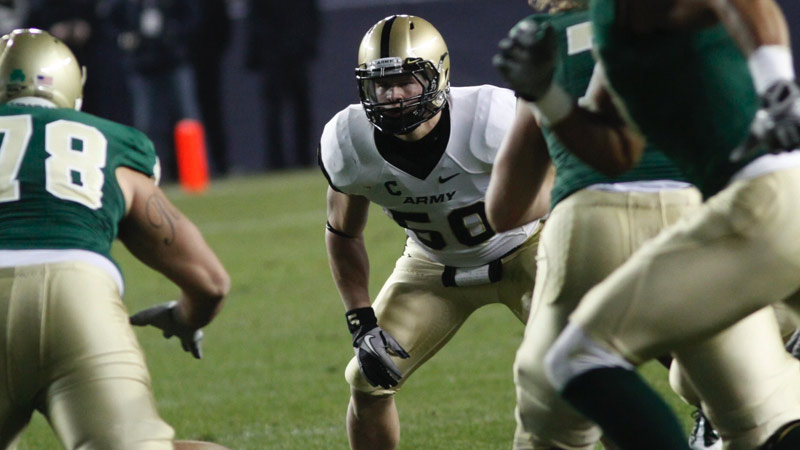
Practicing the Football Over-Under 4-3 Defense requires a structured approach that focuses on both individual skills and team coordination. Here’s a step-by-step guide on how to effectively practice these defensive alignments:
Understanding the Concepts
Ensure that players, especially defensive linemen, and linebackers, understand the basic concepts of the Over and Under 4-3 Defenses. Teach them the alignment adjustments, gap responsibilities, and the rationale behind each alignment.
Individual Drills
Break down the practice into individual drills that target specific skills:
- Gap Control Drills: Have defensive linemen and linebackers practice their gap responsibilities by simulating run plays. Emphasize proper technique, footwork, and hand placement.
- Pass Rush Techniques: Work on pass-rushing techniques such as shedding blocks, using swim moves, and maintaining leverage.
- Coverage Drills: Defensive backs can work on coverage techniques relevant to the alignment, ensuring they can effectively cover receivers in both Over and Under situations.
Alignment and Communication
Practice pre-snap alignment adjustments and communication. Players need to be on the same page regarding shifts from Over to Under or vice versa. Assign a leader, often the middle linebacker, to make these adjustments based on offensive formations.
Team Drills
Integrate team drills that simulate game scenarios:
- Run Defense: Set up run play simulations, and have the defense practice reacting to different offensive formations. Focus on maintaining gap integrity, shedding blocks, and pursuing the ball carrier.
- Pass Rush Situations: Simulate pass plays, and work on creating pressure on the quarterback. This can involve stunts, twists, and coordinated rush strategies.
- Coverage Situations: Incorporate passing plays with different coverage schemes that align with the Over and Under defenses. Emphasize proper zone coverage drops and man-to-man techniques.
Scrimmages and Game Situations
Progress to controlled scrimmages where the offense runs plays against the Over-Under 4-3 Defense. This provides an opportunity to test the defense’s adaptability, communication, and execution under game-like conditions.
Film Analysis
Review practice and scrimmage footage with players to highlight their strengths and areas for improvement. This visual feedback helps players better understand their roles within the alignments.
Coaching and Feedback
Provide constant feedback to players, focusing on their technique, positioning, and decision-making. Encourage them to ask questions and seek clarification to enhance their understanding of the defense.
Repetition and Progression
Like any skill in football, mastering the Over-Under 4-3 Defense requires repetition. Gradually increase the complexity of drills and scenarios as players become more comfortable with the alignments.
Opponent Analysis
When approaching actual games, analyze the opponent’s offensive tendencies to determine whether the Over or Under alignment is more suitable for countering their strengths.
Real-Game Simulation
Finally, implement the Over-Under 4-3 Defense in full-game situations, focusing on quick alignment shifts, proper gap control, and effective coverage.
Remember that consistent practice, attention to detail, and teamwork are essential for effectively executing the Football Over-Under 4-3 Defense on the field.
FAQs
What is the Football Over Under 4-3 Defense?
The Football Over Under 4-3 Defense is a defensive formation used in American football. It employs four defensive linemen, three linebackers, and four defensive backs.
The key feature of this scheme is its flexibility, allowing defenders to shift their positions before the snap to adapt to offensive strategies.
How does the Over Under shift work?
The “Over Under” shift is a crucial aspect of this defense. Before the snap, the defenders shift to one side of the offensive formation, creating an overload on that side. This shift can confuse the offensive line’s blocking assignments and disrupt the timing of the play.
What are the advantages of using this defense?
The Football Over Under 4-3 Defense offers several advantages. It can create confusion for the offense by disguising blitzes and coverages, making it difficult for the quarterback to read the defense.
Additionally, the shift can disrupt the blocking schemes, leading to increased pressure on the quarterback and potential run-stopping advantages.
Is the defense susceptible to misdirection plays?
While the Over Under 4-3 Defense can be highly effective, it’s not immune to misdirection plays and well-executed counters.
If the offense can exploit the shifting defenders’ vulnerabilities, they might find success through misdirection and quick, decisive plays.
How can teams counter the Football Over Under 4-3 Defense?
To counter this defense, offenses can use no-huddle tactics to limit the defense’s ability to shift and adjust.
Pre-snap motion and audibles can also be effective in forcing the defense to reveal its intentions early, allowing the offense to adjust accordingly. Quick, short passes and screenplays can negate the pressure generated by the defense.
Wrapping Up
The Football Over Under 4-3 Defense showcases the strategic depth and adaptability present in football defensive schemes. Its emphasis on shifting and creating pressure can disrupt even the most well-structured offenses.
However, like all strategies, it’s not foolproof and requires intelligent adaptations to counter opposing tactics.
By understanding the nuances of the Football Over Under 4-3 Defense, football enthusiasts can gain a deeper appreciation for the tactical intricacies that make the sport so captivating.
Whether you’re a player, coach, or fan, this defensive scheme opens up a world of strategic possibilities in the game of football. Hopefully, you’ve got my point. Thank you for your time.

